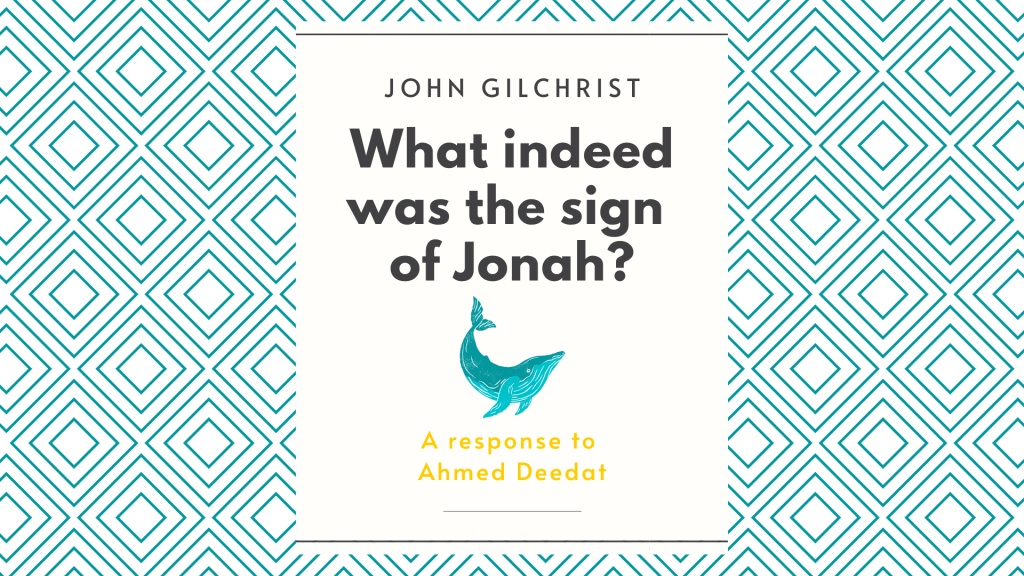Was Jesus Dead or Alive in the Tomb?
What Indeed was the Sign of Jonah?


Chapters
It is an accepted fact in Christian commentaries on the book of Jonah in the Bible that Jonah was kept miraculously alive during the time that he was in the stomach of the fish in the sea. At no time throughout his ordeal did he die in the fish and so came ashore as much alive as he was when he was first thrown into the sea.
In his booklet Deedat takes some of the words in the text quoted above out of their context and makes the statement read "As Jonah was ... so shall the Son of man be" and concludes:
If Jonah was alive for three days and three nights, then Jesus also ought to have been alive in the tomb as he himself had foretold! (Deedat, What was the Sign of Jonah?, p.6).
Although Jesus had only said that the likeness between him and Jonah would be in the period of time they were each to undergo an internment - Jonah in a fish, Jesus in the heart of the earth - Deedat omits this qualifying reference and claims that Jesus must have been like Jonah in other ways as well, extending the likeness to include the living state of Jonah inside the fish. When Jesus' statement is read as a whole, however, it is quite clear that the likeness is confined to the time factor. As Jonah was three days and three nights in the stomach of the fish, so Jesus would be a similar period in the heart of the earth. One cannot stretch this further, as Deedat does, to say that as Jonah was ALIVE in the fish, so Jesus would be alive in the tomb. Jesus did not say this and such an interpretation does not arise from his saying but is read into it. Furthermore, in speaking of his coming crucifixion, Jesus on another occasion used a similar saying which proves the point quite adequately:
"As Moses lifted up the serpent in the wilderness, so must the Son of man be lifted up". John 3:14
Here the likeness is clearly in being "lifted up". As Moses LIFTED UP the serpent, so would the Son of man be LIFTED UP, the one for the healing of the Jews, the other for the healing of the nations. In this case the brass serpent Moses made never was alive and if Deedat's logic is applied to this verse we must presume that it means that Jesus must have been dead before he was lifted up, dead on the cross, and dead when taken down from it. Not only is this illogical, the contradiction between the states of Jonah and the brass serpent (the one was always alive through his ordeal, the other was always dead when used as a symbol on a pole) shows that Jesus was only drawing a likeness between himself and Jonah and the brass serpent respectively in the matters he expressly mentions - the THREE DAYS AND THREE NIGHTS and the LIFTING UP on a pole. It does not matter whether Jonah was alive or not - this has nothing to do with the comparison Jesus was making.
By omitting the qualifying reference to the time period in Jonah's case, Deedat makes the saying of Jesus read "As Jonah was ... so shall the Son of man be" and it is from this unrestricted likeness that he seeks to extend the comparison to the state of the prophet in the fish. But if we follow the same method with the other verse quoted, we come to the exact opposite conclusion. In this case the statement would read: "As the serpent ... so shall the Son of man be" and the state of the serpent was always a dead one. This shows quite plainly that in each case Jesus was not intending to extend the likeness between himself and the prophet or object he mentions to the question of life or death but solely to the very comparisons he expressly sets forth. So we see that Deedat's first objection falls entirely to the ground. A contradictory conclusion automatically results from his line of reasoning and no objection or argument which negates itself can ever be considered with any degree of seriousness.